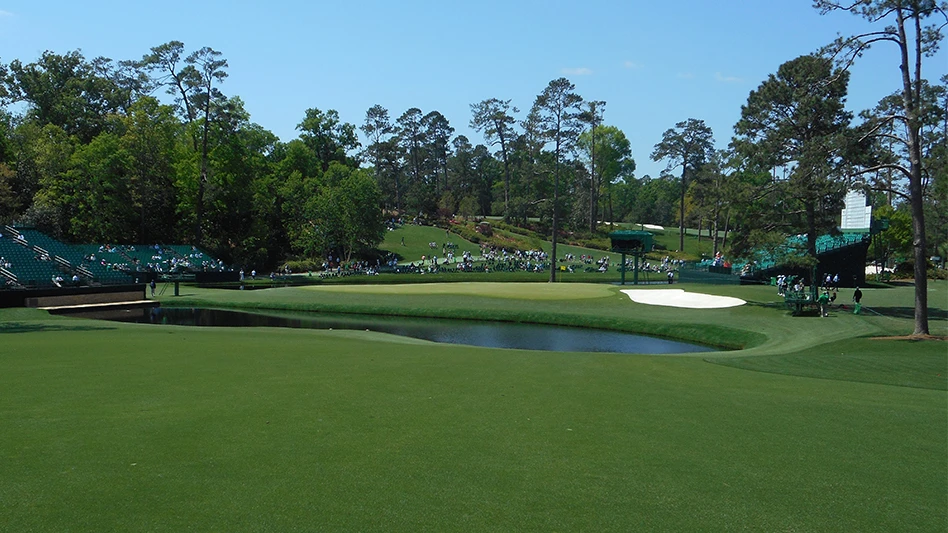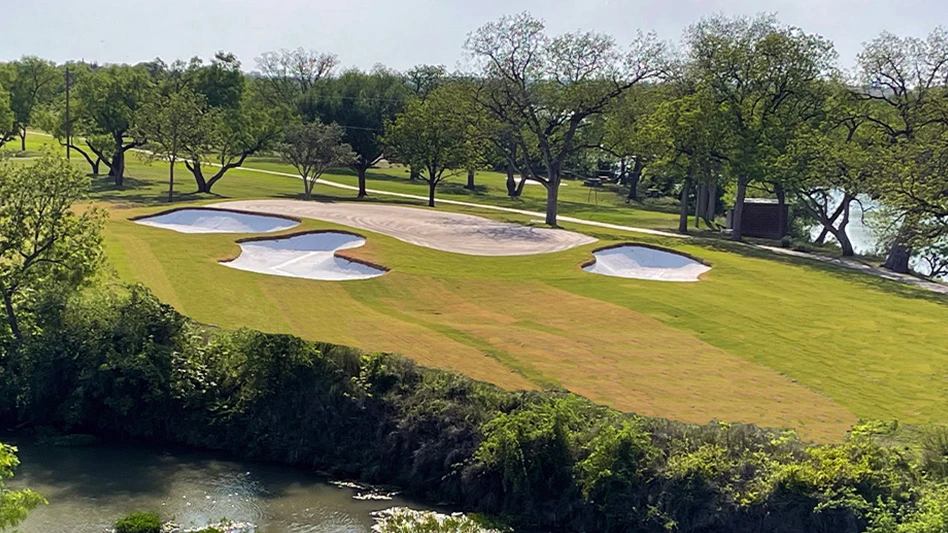At the just completed Golf Industry Show in San Antonio, I enjoyed re-connecting with many of my longtime superintendent friends. One thing I do within a year after opening is to ask them, “What are the five hardest ‘designed in’ maintenance challenges at your course?” I got some updates from those who have now managed their course from two to 20 years.
Sand bunkers were the maintenance challenge most often mentioned. We typically design flashed, cape and bay style bunkers, semi-intentionally favoring aesthetics over ease of maintenance. And, while understood, those with ever tightening budgets (and who isn’t?) wished we would have opted for a design that was more maintenance friendly.
Concerns include both the steep banks around the bunkers, often requiring hand mowing, and the sand itself. This was particularly prevalent in renovations, where superintendents easily saw the change in maintenance regimen. Growth retardants help but are expensive. While I recommend shaggy edges, few others do. Golfers resist them as being too hard, noting that missing the green by 10 feet often creates a harder shot than missing by twenty.
Sand washing and shoveling after a big rain is still a pain point, mostly because it is always an unscheduled and time-consuming operation. Bunker liners and angular sands reduce sand movement but create other problems. Earlier fabric liners are secured with stakes, which have loosened up over time when hit with rakes and even the occasional golf swing. The good news is liners like Better Billy Bunker are now common, and at GIS, there were at least three new fabric bunker liners (from Sand Trapper, Z-Line, and Polylast) that don’t require stakes. When it’s time to replace your liners, there are better options.
Tees are often a concern. Dave Downing, then director of construction and agronomy at Wild Wing Plantation near Myrtle Beach and now a partner at Golf Management Solutions, recalls us agreeing that “Tees can’t be too big.” We were wrong, ending up with an average of 10,000 square foot per tee. Even with a relatively compact core course, tee mowing required over time or two devoted crew members.
We also shared a laugh about his back tees:
Dave: My back tees didn’t need to be that big.
Me: How many golfers use them?
Dave: 50.
Me: 50 a day, a week, a month, or a year?
Dave: 50 since the course opened in 1994!
Fortunately, it’s possible to reduce them to a 15- to 20-foot squares, and similarly nip/tuck middle tees if play is down at your course.
Greens were also mentioned by most superintendents, as most golfers demand they be perfect, and they hope for design help.
We gave Dave some wild greens, attempting to stand out in the crowded Myrtle Beach market. Standing out is a commercial plus, and it must have worked, as Avocet is the only remaining 18-hole course at Wild Wing. However, that doesn’t make any steep slopes such as stair steps, edge rolls or dips any easier to manage. Whether it’s Bermudagrass facing cold north winds, or bentgrass facing warm south winds, steeper green slopes require extra care and some hand watering. Nearly any combination of stress factors such as a steep slope, heavy traffic and/or tight mowing radius hurts turf.
At our recently re-opened Superior National in Minnesota, superintendent Mike Davies is adjusting to the extra work required to maintain his new bunkers and has mentioned steep green slopes. The third green features a steep false front, which was harder to grow in.
Mike also pointed out a few mowing problems. We measured those, and each was caused by final shaping ever so slightly exceeding the recommended maximum 33 percent mowing slope or a sharp transition at mound tops or bases, meaning we should have paid closer attention with a digital level before approving the shaping.
Mike and one other superintendent don’t care for using “flat tile” in sand-based greens, believing it raises the water table, possibly contributing to soggy greens in early spring. We have used flat tile to save money, and avoid bringing up rock in trenching, but are re-thinking that practice in the name long-term maintenance.
Sponsored Content
Redefining Wire Processing Standards
In nonferrous wire and cable processing, SWEED balances proven performance with ongoing innovation. From standard systems to tailored solutions, we focus on efficient recovery and practical design. By continually refining our equipment and introducing new technology, we quietly shape the industry—one advancement at a time.
Sponsored Content
Redefining Wire Processing Standards
In nonferrous wire and cable processing, SWEED balances proven performance with ongoing innovation. From standard systems to tailored solutions, we focus on efficient recovery and practical design. By continually refining our equipment and introducing new technology, we quietly shape the industry—one advancement at a time.
Sponsored Content
Redefining Wire Processing Standards
In nonferrous wire and cable processing, SWEED balances proven performance with ongoing innovation. From standard systems to tailored solutions, we focus on efficient recovery and practical design. By continually refining our equipment and introducing new technology, we quietly shape the industry—one advancement at a time.
Sponsored Content
Redefining Wire Processing Standards
In nonferrous wire and cable processing, SWEED balances proven performance with ongoing innovation. From standard systems to tailored solutions, we focus on efficient recovery and practical design. By continually refining our equipment and introducing new technology, we quietly shape the industry—one advancement at a time.
Sponsored Content
Redefining Wire Processing Standards
In nonferrous wire and cable processing, SWEED balances proven performance with ongoing innovation. From standard systems to tailored solutions, we focus on efficient recovery and practical design. By continually refining our equipment and introducing new technology, we quietly shape the industry—one advancement at a time.
Sponsored Content
Redefining Wire Processing Standards
In nonferrous wire and cable processing, SWEED balances proven performance with ongoing innovation. From standard systems to tailored solutions, we focus on efficient recovery and practical design. By continually refining our equipment and introducing new technology, we quietly shape the industry—one advancement at a time.
Sponsored Content
Redefining Wire Processing Standards
In nonferrous wire and cable processing, SWEED balances proven performance with ongoing innovation. From standard systems to tailored solutions, we focus on efficient recovery and practical design. By continually refining our equipment and introducing new technology, we quietly shape the industry—one advancement at a time.
Sponsored Content
Redefining Wire Processing Standards
In nonferrous wire and cable processing, SWEED balances proven performance with ongoing innovation. From standard systems to tailored solutions, we focus on efficient recovery and practical design. By continually refining our equipment and introducing new technology, we quietly shape the industry—one advancement at a time.
Fairways got questioned, as in, “Why are there so much of them?” Wider fairways provide strategic options, accommodate average players, and generally speed play. But, with the cost of chemicals, we compromise on total area and make sure every inch of fairway is truly integral to the design. And, we typically discuss grass varieties more than folks at a Colorado pot shop, but choosing for color or playability is often regretted by northern superintendents.
Undersized and poorly set catch basins (whether original or settled later due to poor surrounding compaction) are more common than they should be, as well as poorly compacted drainage and irrigation pipe trenches. Constant attention by the daily supervisor is certainly required for some contractors. And, while we are complaining, why is it so hard to get a contractor to provide a timely and accurate as-built drawing? Or on renovations, get them to finish out and clean up by contractors is not always to the satisfaction of the superintendent. I hate seeing construction debris years after opening!
Often, the cost of under brushing tree canopies is left out of initial construction, but then left out of maintenance budgets as well. Again, technology may be on the way to reduce costs. At our Tempest Golf Club, under construction in Gladewater, Texas, contractor Peter Dejak and Signet Golf is using a small under brushing machine that makes quick work, allowing him to cost effectively underbrush not only the golf course, but surrounding lots which has increased real estate sales.
Hopefully, this will serve as a checklist and reminder to those overseeing construction now. I have amended my site visit checklists based on my experience, vowing to learn from experience and not repeat the same mistake twice. The devil is always in the details, and thorough construction evaluation makes a difference.
Get curated news on YOUR industry.
Enter your email to receive our newsletters.

Explore the March 2018 Issue
Check out more from this issue and find your next story to read.
Latest from Golf Course Industry
- PBI-Gordon promotes Jeff Marvin
- USGA investing $1 million into Western Pennsylvania public golf
- KemperSports taps new strategy EVP
- Audubon International marks Earth Day in growth mode
- Editor’s notebook: Do your part
- Greens with Envy 66: A Southern spring road trip
- GCSAA’s Rounds 4 Research auction begins
- Quali-Pro hires new technical services manager






